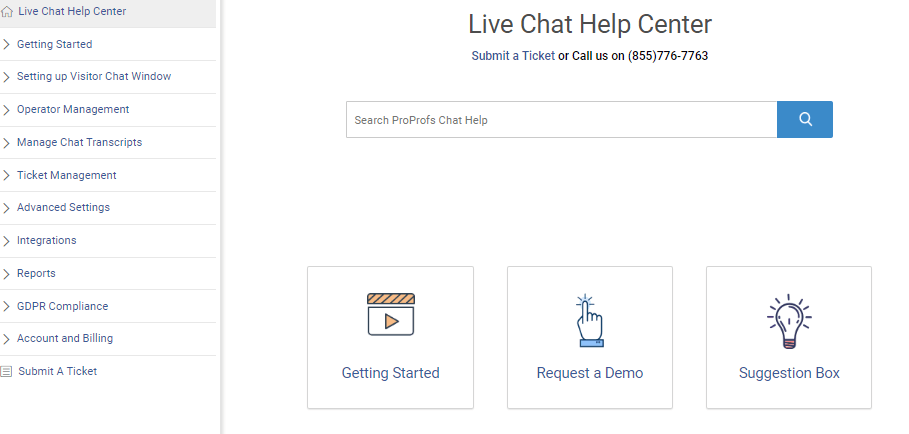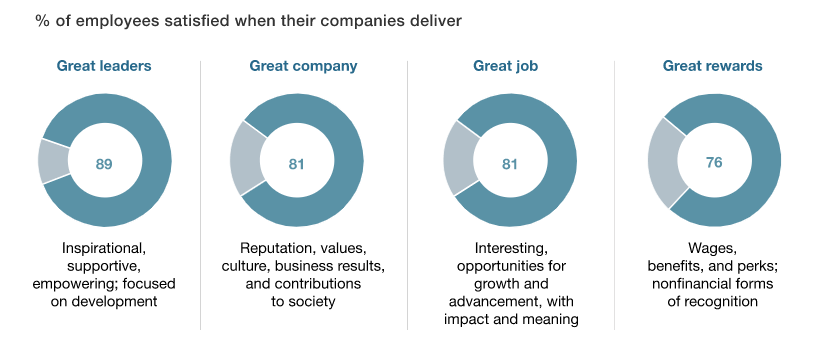Did you know that 56% of people around the globe believe that companies need to take action on feedback provided by their customers?
Well, customer feedback is exactly what’s going to help your business improve its customer service process efficiently.
You need to take into account their expectations, needs, and final feedback for your services to create an excellent customer service training program.
To create an awesome training program, you can use an online customer service training software that:
- Engages customer service operators till the end
- Helps operators to learn at their own pace
- Learn anytime, anywhere
- Helps you track how far they’ve reached through insightful reports
- Test their knowledge with online quizzes
Watch & Learn: How to Create an Online Training Course ?
In short, it is essential for your business to create a customer service training program to improve customer experience and loyalty. And while you create one or update an existing one, make sure you take customer feedback into account.
If you fail to acknowledge them when creating the best customer service training program for employees, you can end up facing consequences like:
- Losing more than 50% of customers who end up leaving because of poor customer service
- More than 90% of non-returning customers who leave after having one bad experience with the company will leave without complaining
This is exactly why we see a big volume of articles online talking about customer service and its importance. If anything, you may find it difficult to be one of those 80% of the companies who would compete solely based on customer experience by 2020.
Source: Mckinsey.com
These studies and stats validate the importance of training your customer service team in the right direction to ensure complete customer delight. Only then can businesses authenticate engagement with their customers and those influenced (by the word-of-mouth publicity) to stick to their brand.
Blackberry, Sears, Kodak, and JCPenny are the best examples of brands losing their customers because of their complacency. Once hailed as innovators, they simply stopped defining trends and were forgotten by their customers gradually. They forgot to incorporate new technological advancements into their products and service.
They weren’t prompt like their competitors to adopt customer service products like:
- Live chat software to provide a prompt and immediate solution to customers
- Help desk software to make sure no leads or customer pain-points go unanswered
- Knowledge base software to create online knowledge repository that answers some of the FAQs faster
Now, to authentically engage with your customers, you have to offer a highly well-defined, expertly-curated, and personalized customer support system which is a hybrid of automation, technology, and well-trained skill set.
So, do you need to roll-out your current CS system and invest in some high-end software? Is your current customer support team working in the right direction? Do you, or you don’t want to be affected by the customer experience index for your services and products? And, what can you do to offer the next-level customer journeys?
Let us find out answers to the above-mentioned and lots of other questions related to customer experiences and how customer service training can be of consequence in this regard.
What is Customer Service Training?
As the name implies, Customer Service Training refers to teaching, training, and cultivating all those employees that interact with customers so that they can drive successful delivery of delightful and positive customer experiences.
Training for customer service can comprise a lot of things such as:
- Tutorials
- Seminars
- Expert lectures
- Activities
- Presentations
- Study sessions and lots more
- Knowledge repository based company learning resources
The ultimate aim of all these is to teach your customer support team the right way to interact with customers and to train them for coming out of sticky situations, like saying ‘NO’ to some priority customer or going above-board with customer services.
Now, when we talk about employee customer service training, there are some surprising examples. Let us have a look at them:
- At Disney, all the employees are also called cast members and mandatorily undergo Traditions Training irrespective of their job roles and responsibilities.
- Zappos has a popular and unique employee onboarding program. It comprises extensive training that gets started right after an employee is hired. The company has a scintillating record in the service sector and even urges its employees to leave with a financial incentive if they find it hard to blend in the company culture after the training.
Both these brands have countless features in customer service stories, case studies, and journals.
A good customer service skills training program concludes with employees taking thoughtful takeaways from insights into various examples and market trends discussed in it. It empowers them to view customer service in a new light and to redesign their .
Now that we have developed an initial idea let us move on to find the importance of customer service training for employees.
Customer Service Training: Why Is It Important, and What Makes It Consequential for Every Business Organization?
As per a customer service report from BCG, companies can achieve a lot by investing in high-end customer service programs, such as employee customer service training. It also cites the example of Cemex – a commodity-based brand that has achieved a 5 to 7% price premium by doing so.
Before we begin talking about the importance of customer service training, it is important to note that the goal behind every such training program should be well-defined. Instead of being everything that your customers want, your goal should be to understand the needs of different customer segments and to provide tailored brand offerings to meet them precisely. One of the best ways to do so is by investing in training and hiring.
But then again, if you have to hire professionals for customer service, you have to ensure that they have:
- An EQ (emotional quotient) to understand customer anxiety, its levels, and the right way to convey to them that they are being heard.
- Communication skills that can leave lasting impressions.
- An uncanny knack of figuring out the best offering for every incoming customer that aids in designing personalized customer experiences.
- An undying passion to generate positive reviews, and an urge to constantly evolve in the domain.
- A learner’s bend of mind to be resourceful when the need arises.
An impeccable customer service system has various dimensions such as:
- A worthwhile ticketing system to make sure you don’t keep your customers infinitely waiting.
- Consolidated customer helpdesk to compile all kinds and customer communication such as Email, messages, chats, and call logs, etc.
- A personalized and proactive customer service system that shows customers what they want to see and what they want to shop.
- Perfect assimilation of automation, technology, and human skillset to process the unstructured data-driven from various channels to find actionable insights into customer behavior, preferences, and demands.
- Collection of customer feedback, processing the data, and working on the inferences drawn from the same.
And, undoubtedly, a commendable customer service representative training program is able to educate and train employees in all these spheres.
This statement alone is more than enough to define the extent of importance a training program has for a customer-centric business organization.
Further, customer experience training should focus on three areas:
- Commercial awareness
- Interpersonal skills
- Teamwork
Take a look at the following infographic for more understanding:
Source: Mckinsey.com
Hence, training your employees can help you revolutionize your customer service and reinvent your customer service strategies.
Now that we have realized the importance of well-crafted customer service training for employees let us move on to find the different types of training.
Types of Customer Service Training: Identify What You Need?
Training your customer support team can be broadly classified into two categories:
- Training new employees
- Regular training sessions for existing employees
Both of them have different requirements and core integrals. Let us explore each one separately.
I. Training New Employees
Your new customer support employees face troubles and have various questions in the initial days.
That’s why it is crucial to have a great onboarding and training program which:
- Helps new employees to complete the smooth transition into the existing company culture
- Enables your new employees to understand the core customer service skills that help you stand out in the market
To create a new employee training course, we’d suggest you make the most out of a customer service LMS tool.
It will allow you to:
- Integrate a course authoring tool that helps you create custom-branded courses
- Centralize training with virtual classrooms
- Help course participants to discuss and collaborate and solve problems with the learners’ community
- Evaluate new employees to understand how far they’ve absorbed the essence of core customer service skills
Watch: How to Create Employee Training Courses Online ?
Sign up for ProProfs Training Maker for free to Create Your Employee Training Course
Other than that, you also need to learn about various stages of a successful learning and development strategy.
Check out the basic framework below to briefly understand those stages effectively:
Source: Mckinsey.com
Learn: How to Develop Your First Employee Training Program
Take a brief look at what comprises customer service training at this stage.
1. General Interaction Training
The newly hired employees are acquainted with the team, and core mentorship roles are defined. Organizing team lunches, meet-and-greet activities, and doing a general introduction are some of the common activities on stage.
2. Establishing Employee Expectations
Your newly hired employees should know their job roles and responsibilities in the initial months of post hiring. They must have a clear understanding of the expectations you have from them as a customer support staff.
3. Tool Tutorials & Company Learning Resources
Having a knowledge repository in place helps your business organization train the newly hired employees. For example, ProProfs Chat has a separate knowledge repository that is open for both employees and their users.

The knowledge repository is divided into multiple categories, giving customer service operators an idea where they can find the possible answer faster.
4. Introducing Brand Offerings
The last step in customer service skills training for new employees is to introduce the products and services offered by your brand. Dedicated product training must be supervised by expert professionals so that the new employees can learn about the products and services in detail.
Take a look at the way a great onboarding program and company culture can boost employee satisfaction.

Source: Mckinsey.com
For a more detailed understanding of various steps involved in customer service training of newly hired employees, please refer to the following infographic:
Now that we have grasped an understanding of training programs for newly hired employees, let us move on to find the customer service training requirements for existing employees.
Read More: How to Use Your Knowledge Base for Employee Onboarding
II. Training Existing Employees
A regular customer service training program is essential for the already existing employees as well. This not only boosts the productivity of your company but also consistently upgrades the customer service system.
As per BCG, learning can drive revolution at workplaces and can develop your workforce in many impressive ways. Further, frontline leaders can redefine your business goals and revenues. Also, customer journeys are driven by different forces, and if you master them, you can produce astounding results in customer happiness and satisfaction.
Hence, investing in customer service training for already existing employees is a must.
So, what does an effective training program for your customer support team look like? What are some ways to make your training programs effective? What amounts of passive learning can be done by your employees via training programs?
Let us find out!
1. Time-Sensitive Training
Gone are the days when doing a business meant enjoying a smooth sail in calm waters. With the rise of cutting-edge competitive markets and customers hopping companies at the slightest discomfort, it has become mandatory to have a crisis training module in place.
The latest example is the COVID-19 pandemic that has shaken the entire world with its fury and is going to do it yet again after subsiding (economic depression).
There are two types of time-sensitive training:
- Crisis Training
There can be any type of crisis situation that can pose a threat to the well-being of your business, its assets, employees, resources, and the lives of the stakeholders in danger. At such times, it becomes important to have a crisis training program in place and educate your employees regarding the protocol, job responsibilities, and workflow, etc. in the wake of a crisis.
- Product or Company Updates
This type of training proves beneficial when your company undergoes a change such as server migration, product upgrades, site migration, software migration, automation introduction, and other such core changes. Offering training manuals and materials as well as physical sessions to work through these changes is a must and highly crucial activity.
2. One-Time Training
Building activities let the steam cool-off and help the employees to stay focused on working together as a team. Friendly competitions and games can boost the communication and problem-solving skills of your staff.
- Industry Updates
The customer service team needs to be updated about the latest norms, legal procedures, regulations, and other such industry-specific standards. Organizing industry updates training helps them stay in tune with all the recent changes and updates.
Now that we have had a detailed overview of various types of customer service training and procedure for the same for newly hired and already existing employees let us move on. In the next section, we will compare whether it is favorable to hire new employees to boost your customer experience or to train the already existing employees.
Related Read: Employee Training for Motivation, Success, and Retention
Comparison Between Training a Newly Hired Customer Service Rep & An Existing Rep
Training existing staff is much easier as compared to training a newly hired staff; especially, if you are talking about training for customer services. An experienced employee already has the requisite knowledge in relation to company policies, culture, and past experiences. He already knows about the tools and automation used by your company.
Further, you have to input a lesser number of resources (time, effort, and money) to train them, as compared to a newly hired employee.
However, when compared to a skilled new employee, many business owners find it hard to prioritize the already existing employees. They feel that instead of training the existing employees, hiring a skilled employee is an easier way to accumulate talent. This is where they make a mistake.
As per a study conducted by U.C. Berkeley, hiring a new employee costs around the US $4,000 to hire a new employee. And, when the new employee is hired to replace management-level employees, the cost rises to the US $7,000.
So, it is vital to calculate all the costs and compare all the pros and cons before you make the final choice.
This brings us to the completion of the customer service training overview. Next, we will discuss some industry-approved and expert-recommended customer service training tips to help you ace your training modules.
FREE. All Features. FOREVER!
Try our Forever FREE account with all premium features!
Customer Service Training Tips for Emotional-intelligence & Performance-intensive CS Team
So, What skills do you need for customer service? What are the areas of customer service? And, how do you provide excellent customer service? After reading these tips, you will be able to find answers to all these questions. So, read them carefully to amp-up your customer service training modules.
1. Emotional Intelligence is a MUST
You cannot offer delightful customer experiences if you have zero or average emotional intelligence. Emotional intelligence enhances your customer service and works wonders for your image. There are 5 dimensions of emotional intelligence – Empathy, Motivation, Social Skills, Self-awareness, and Self-regulation. Incorporating Emotional Intelligence in your customer support system is a must if you wish to keep your customers.
Takeaway: You have to ensure that your customers feel that they are valued and respected every time they communicate with you. Listen to them, their anxieties and worries, and offer a humanistic answer or solution.
2. Inculcating ‘Hard’ Skills for Keeping Your Customers
This is often called experience engineering – a term coined to offer effortless customer experiences by a collaboration of emotional intelligence with mutually beneficial solutions for vendors and customers.
These hard skills comprise the following:
- Customer advocacy in which vendors tailor their products and services to align with customer’s needs and proactively work towards offering personalized experiences.
- Change of verbiage or opting for a positive body and verbal language that resists the use of ‘no’, ‘can’t’ and ‘inability’ etc.
- Anchoring in which a given outcome is projected as the best possible solution to a customer without being rude or sentimental.
Takeaway: Training your team only in soft skills is not going to help you keep customers. You have to ensure that they learn other essentials requiring a more compelling use of skills and knowledge to offer customer satisfaction. Opting for statistical and case study-based customer service training materials is an excellent way to do so.
3. Product and Technical Skills
Educating your customer service staff about the latest tools, products, automation, and strategies are one of the best ways to roll-out changes without much ado. In order for them to use a new product or tool properly, they have to know it inside-out.
A few ways to enhance the technical skills of your team are:
- Mentorship Program: Assign a mentor who has an impeccable command over the skill and who comes from a different department. This way he or she can offer a better and more bias-free overview of different business segments.
- Job Shadowing: This offers new perspectives on customer service and can prove helpful for newly hired employees as well as existing ones.
- Creating a repository with knowledge base software: A knowledge repository enables a company to simplify its training procedures and design highly relevant training modules for its employees. You can refer to it anytime and add more information to it anytime.
- Demonstrations: Live demonstrations are one of the best customer service training materials where team members can interact with each other and offer feedback.
Takeaway: Don’t overlook the importance of training your customer service staff about the products and technologies. Eventually, they have to use them. Assigning mentors, job shadowing, demonstrations, and creating knowledge repositories are some of the best practices in this regard.
So, all in all, customer service training is a holistic approach to teaching your team the best way to deliver exceptional customer experiences.
This brings us to the completion of our discussion on customer service training, its meaning, and importance, its types, and some beneficial tips for training in customer service. We hope that all our readers draw thoughtful inferences from here and are able to design highly relevant training modules.
Now that we know how to train the customer service team, let’s take a look at some of the frequently asked questions below.
Q. What skills do you need for customer service?
You need a good amount of skills to provide delightful customer service. Some of them are inclusive of:
- Active listening
- Adaptability
- Attentiveness
- Conflict resolution
- Creativity
- Decision-making
- Effective communication
- Empathy
- Friendliness
- Knowledge of your product or service
- Open-mindedness
- Patience
- Quick thinking
- Responsiveness
For more customer service skills, read this blog post.
Q. What are the areas of customer service?
There are six areas of customer service. They are:
- Customer retention
- Proactive support
- Quality management
- Self-service
- Communication skills
Q. How do you provide excellent customer service?
To provide excellent customer service, make sure you:
- Provide prompt response when customers approach you
- Offer proactive customer service with live chat software
- Provide self-help to customers so they can arrive at a decision faster
- Never miss out on a customer support opportunity by getting a help desk system onboard
- Help your operators track potential leads at their next visit with CRM platform
 Tips
Tips
We’d love to hear your tips & suggestions on this article!
FREE. All Features. FOREVER!
Try our Forever FREE account with all premium features!


 We'd love your feedback!
We'd love your feedback! Thanks for your feedback!
Thanks for your feedback!







